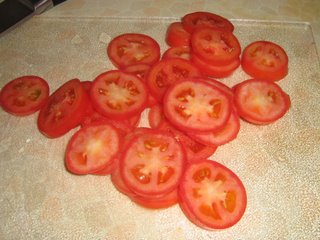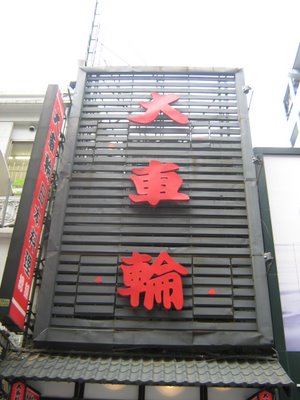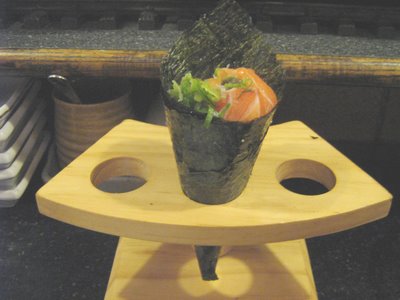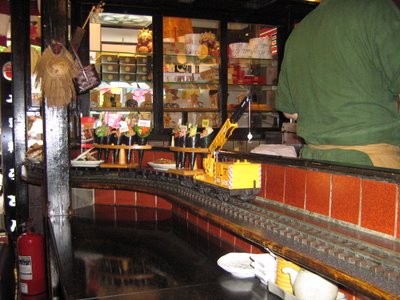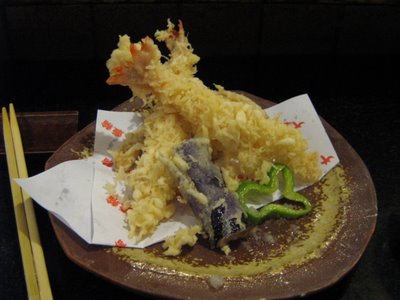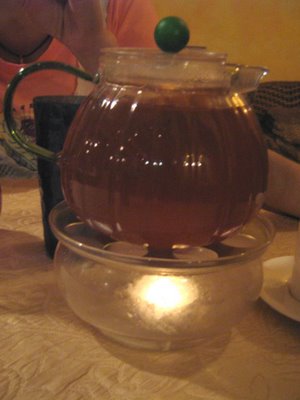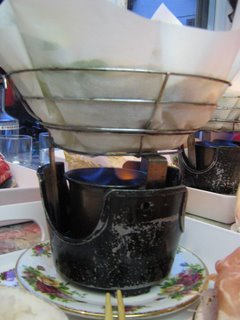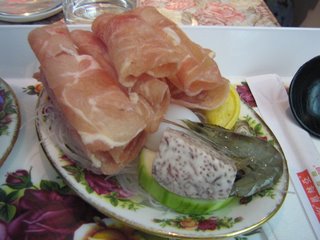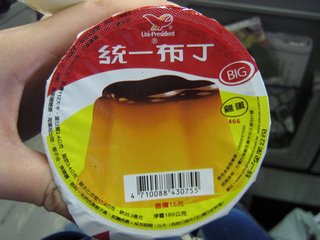I can say with absolute certitude, that
Din Tai Fung makes the ultimate, BEST tasting soup dumplings on the planet. Standing outside of the restaurant gives you no hint of any of the deliciousness that await you inside. All you see are mobs, waiting, sometimes literally around the block. Right under the red Din Tai Fung sign on the right side of this picture, is a huge line of Japanese tourists. In Japan alone, there are 11 branches of this restaurant, whereas, in it's native Taiwan, there are only 2. You know my theory: if Japanese tourists flock to it, it must be REALLY good. The wait was so long that some people were going to the bookstore next door to waste time before sinking their teeth into the tender dumplings.

A typical soup dumpling meal starts with condiments. From the left, starting from the cup of tea: ginger, vineagre, and two things of soy sauce on the caddy.

I suppose this is a form of what English speakers call Kimchi. It's marinated/pickled/preserved cabbage, but it's simple and not spicy at all. There are no complex scales of acidity or mix of spices. The cabbage is stored in a salt solution and eaten while relatively fresh.

Seaweed and do gan appetizer. I've never encountered the occasion where I had to use do gan in an English context. I guess you would call it dry tofu, but when I think of tofu I think soft. Do gan is actually pretty tough or chewy or crumbly. Not soft at all.

Swan La Tang: literally, sour and spicy soup. English speakers know this as hot and sour soup. I dare not try the versions they serve in Chinese take-out type restauarants because they add too much cornstarch and the soup turns into more of a slime. This soup was just the right consistency - thick but not goopy.

...and the famed soup dumplings.

In every steaming chamber there are exactly 10 dumplings, and each dumpling has the same number of folds at the top (15 or 16, I forget). The skins that hold the meat are very thin and very stretchy, one wonders how they possibly stay intact to keep the savory soup inside the little delicate pouch. At lower quality soup dumpling places like
Joe's Ginger/Joe's Shanghai, they don't pay enough attention to the skins and they break inside the steaming chambers or when you pick them up with your chopsticks. The meat is soft and slightly chewy full of juice, with the flavors perfectly balanced so that the carnal taste of meat is a mere subordinating shade contrasted with the other ingredients. There is no way anybody could stop at just one. Din Tai Fung soup dumplings are perfectly shaped and orgasmically flavored bites of joy; a food group in its own right worthy of being placed on your "ten-things-to-eat-before-I-die" list.
The secret to there being actual soup in these dumplings and not in other types of steamed dumplings or buns, is that they put pork broth that has been solidified into gelatin (simply by refrigeration) inside of the skins along with the meat. When the dumplings are wrapped, they are cold and the soup is solid. When the dumplings are steamed, the soup returns to its liquid form and presto! soup inside a soup dumpling.
The proper way to eat these dumplings:
1. pick one up from the steaming chamber and place in soup spoon.
2. bite a small hole to release the hot steam and blow so that the soup does not burn your mouth.
3. drink the soup from the small hole you've made
4. dip the dumpling in the vineagre/ginger dipping sauce that you made while eating the appetizers
5. eat the soup dumpling in one bite.
I don't exactly do it that way, but everybody has their own way of eating soup dumplings. This is how I do it:
1. pick a dumpling up from the steaming chamber and place in soup spoon.
2. bite a small hole to release steam and drink the soup
3. drink some of the soup, leaving about 1/3 of the original volume of liquid
4. chomp the remaining soup and dumpling in one bite
5. chew dutifully
6. smile
After dinner is a traditional Chinese dessert, sweet sticky rice. It's called
Ba Bao Fan, or 8-treasure rice. I don't really remember the eight treasures that go in it, but some of them are nuts, or dried fruit.

On our way out we saw the true secret to consistently great tasting soup dumplings: a gaggle of masked chefs quickly folding their way through gajillions of dumplings every night. All this, just to satisfy the hungry regulars (my aunt) and tourists who make the pilgrimage to Din Tai Fung.

 Bottom picture, from left: chicken juice flavored (literally, usually just salt and chicken broth), Thai "leaf" chicken flavored, and regular ol' sour cream and onion.
Bottom picture, from left: chicken juice flavored (literally, usually just salt and chicken broth), Thai "leaf" chicken flavored, and regular ol' sour cream and onion. *the baseball player you see on the nori package is Wang Chien Ming, Taiwanese pitcher extraordinaire for the Yankees.
*the baseball player you see on the nori package is Wang Chien Ming, Taiwanese pitcher extraordinaire for the Yankees.



















